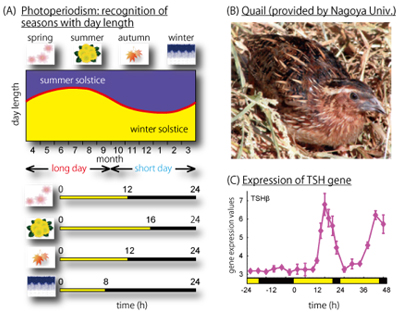| RIKEN Center for Developmental Biology (CDB) 2-2-3 Minatojima minamimachi, Chuo-ku, Kobe 650-0047, Japan |
The work was enabled by the application of DNA microarray technology to the quail, which serves as a useful model for the study of seasonal breeding due to its rapid and dramatic responsiveness to changes in day length. As with many birds, the Japanese quail maintains gonads of small size in non-breeding periods, reducing its load, developing them to functional size only at the start of mating season. Yoshimura’s group had previously shown that thyrotrophin secretion was one of the earliest events in the long day-induced pathway.
The joint project began with a comprehensive analysis by DNA microarray of changes in gene expression when birds raised in short day length conditions were shifted to a longer light exposure environment, similar to the change in day length from winter to spring. Of the nearly 30,000 genes analyzed, roughly 300 showed changes in expression level associated with the day length shift, with TSH being the earliest responder. Further study revealed that this hormone is triggered in the pars tuberalis, a section of the anterior pituitary lobe, and binds to its receptor, TSHR, in the overlying hypothalamus, enabling it to bypass the blood-brain barrier and enter the brain.
The group next looked for a possible interaction between thyrotrophin and a second factor known as type-2 deiodinase, or DIO2, which Yoshimura’s lab had previously shown to be important in gonad activation, and found that TSH indeed upregulates DIO2. They confirmed this in vivo by injecting TSH into cerebral ventricles, which stimulated both DIO2 expression and gonadal growth.
In addition to the identification of this molecular pathway involved in seasonal breeding, the discovery of the role of the pars tuberalis put paid to a longstanding question of the function of this hitherto mysterious structure. The new link between TSH, which is known for its roles in thermoregulation and metabolism, and reproduction also represents an important discovery, that may lead to new insights into seasonal biological cycles with implications in fields ranging from animal husbandry to seasonal affective disorders.
|
|||||
|
|||||
 |
| Copyright (C) CENTER FOR DEVELOPMENTAL BIOLOGY All rights reserved. |
